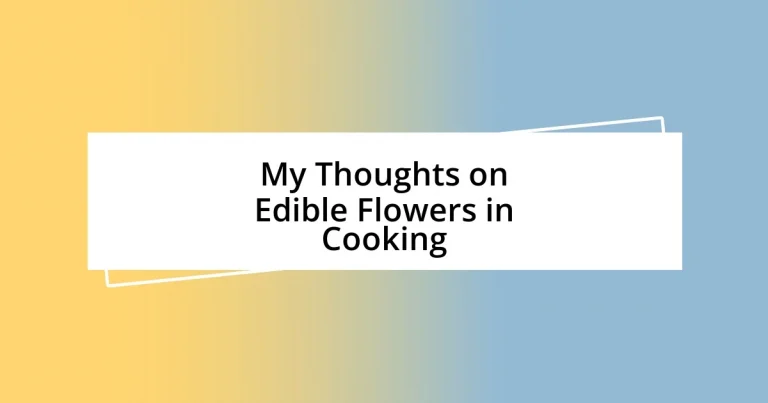Key takeaways:
- Edible flowers enhance dishes with unique flavors, textures, and cultural significance, turning simple meals into artistic creations.
- When choosing edible flowers, prioritize freshness, pesticide-free quality, flavor compatibility, seasonality, and cultural knowledge for an enriching culinary experience.
- Simple recipes like summer salads with nasturtium, lavender lemonade, and yogurt parfaits with borage can showcase the delightful use of edible flowers in cooking.

Introduction to Edible Flowers
Edible flowers have a charm that captivates not just the palate but also the imagination. I remember the first time I incorporated nasturtiums into a salad; their peppery flavor surprised me and turned a mundane dish into something special. It’s fascinating to think about how something so pretty can add layers of taste and texture to our meals, isn’t it?
As I explore different cuisines and dishes, I’m constantly amazed by how cultures around the world celebrate the use of flowers. For example, in Japanese cuisine, cherry blossoms, or sakura, are often utilized in teas and desserts. This practice of using flowers in cooking isn’t just about flavor; it’s about artistry and tradition. Have you ever wondered how your great-grandparents might have used flowers in their recipes?
When I think of edible flowers, I can’t help but admire their versatility. From vibrant, colorful violets to delicate chamomile blooms, these natural ingredients do more than beautify a plate—they tell a story. Each flower carries a unique flavor profile, often rich with history and cultural significance. Isn’t it intriguing how something so simple can bring joy and creativity to our kitchens?

How to Choose Edible Flowers
Choosing edible flowers can be both exciting and slightly overwhelming. I remember the first time I strolled through a farmer’s market and was confronted with a rainbow of blossoms. The colors drew me in, but knowing which ones to pick took a little research and instinct. It’s essential to consider not just the look but also the flavor and compatibility with your dishes. Some flowers are sweet while others have a more earthy or spicy note, adding a whole new dimension to your culinary creations.
When selecting edible flowers, keep these points in mind:
- Freshness: Look for bright, unblemished flowers. Dull colors or wilting petals can indicate age.
- Pesticide-Free: Always confirm that the flowers haven’t been treated with chemicals. Often, growers will label their produce as organic.
- Flavor Profile: Consider how the flower’s taste complements your dish. For example, I often use borage for its cucumber-like flavor in salads.
- Seasonality: Some flowers are only available during specific seasons, so planning ahead can enhance your cooking experience.
- Cultural Knowledge: Research the flowers traditionally used in cuisines that interest you; it can lead to exciting new dishes.

Best Edible Flowers for Recipes
I’ve come to appreciate how different edible flowers can transform a dish. For instance, when I first used marigolds, I was taken aback by their citrusy notes. They not only added vivid splashes of color but also a delightful hint of flavor that made a simple rice dish sing. It’s these little surprises that make cooking so enjoyable.
Lavender is another favorite of mine. It brings an aromatic sweetness that’s particularly charming in desserts. I once made lavender-infused sugar for cookies, and the fragrance alone transported me to a sunny field. Pairing delicate lavender blooms with honey in a simple yogurt parfait became a crowd-pleaser, and I constantly find myself reaching for it during spring.
Let’s not forget about pansies and their mild, sweet taste. I often use them as a garnish for dishes; their vibrant colors make my servings visually stunning. The first time I decorated a cake with pansies, I was amazed at how they could elevate even the simplest of flavors. Below is a comparative overview of some of the best edible flowers you might consider incorporating into your cooking.
| Flower | Flavor Profile |
|---|---|
| Nasturtiums | Peppery, slightly spicy |
| Marigolds | Citrusy, zesty |
| Lavender | Aromatic, sweet |
| Pansies | Mild, sweet |
| Borage | Cucumber-like, fresh |

Simple Recipes with Edible Flowers
One of my favorite simple recipes featuring edible flowers is a vibrant summer salad topped with nasturtium petals. I remember the first time I made it; the peppery taste of the flowers complemented the freshness of arugula and cherry tomatoes perfectly. The visual appeal is simply irresistible—each bite feels like a celebration of summer.
Another delightful dish I’ve enjoyed is lavender lemonade. It’s incredibly refreshing on a hot day. I steeped the lavender in boiling water with sugar, and it transformed into a fragrant syrup. When I poured it over ice and topped it with lemon juice, I was transported to a lovely garden. It’s a drink that not only quenches thirst but also delights the senses.
For a quick dessert, I often whip up a yogurt parfait with honey and borage flowers. The cucumber-like flavor of the borage brings a unique twist that I didn’t expect at first. Layering this with tangy yogurt and sweet honey creates a texture explosion that’s so satisfying. It’s like taking a moment to enjoy nature, right on my plate—have you ever tried something so unexpected that it changed the way you look at food?














